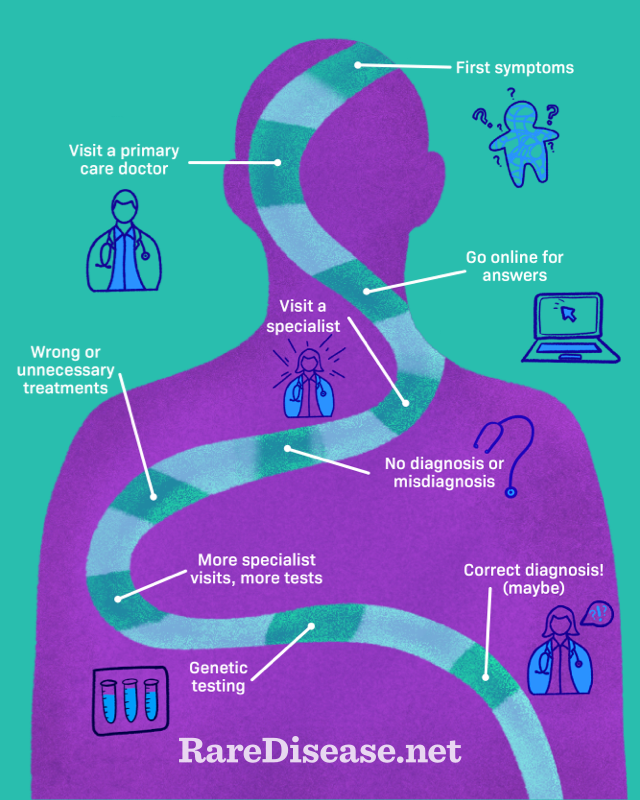The Journey of Diagnosing a Rare Disease
Reviewed by: HU Medical Review Board | Last updated: November 2023
The quest for a rare disease diagnosis is often referred to as a "journey" or "odyssey." The reasons it may take years to find a diagnosis are many. It is common to experience inconsistent or fragmented medical care and long waits to see specialists. You may see many doctors who do not communicate well or share information. Finally, it can be hard to find doctors who look at the whole patient and all your different symptoms.1,2
This may seem obvious, but for someone to be diagnosed, the medical community must first know many things. They must have knowledge that a disease exists and understand:3
- What causes the disease
- Symptoms and complications of the disease
- How or if it progresses, and how slowly or quickly
- Which treatments work and which do not
- Possible lifespan for people with and without treatment
Because of these unknowns, it takes the average person with a rare disease 6 to 8 years to get an accurate diagnosis.4
The National Organization for Rare Diseases found that:1
- 36 percent of people they surveyed were diagnosed with a rare disease in 1 year
- 28 percent said it took 7 or more years
- 38 percent received an incorrect diagnosis during their journey
Types of rare disease patients
There are 2 groups of undiagnosed patients: not yet diagnosed and SWANs.3
"Not yet diagnosed" refers to people who live with an undiagnosed condition. Generally, these people should be diagnosed. But, they have not yet found a doctor who can accurately diagnose their condition. This may occur because symptoms may be confused with more common conditions, leading doctors to the wrong conclusion.3
"SWAN" stands for syndromes without a name. SWANs are people for whom there is no diagnostic test to identify their disease. These people have syndromes and diseases that have not yet been identified or described by doctors. Misdiagnosis is common because these conditions may be mistaken for known diseases.3
People in both these groups may never receive a correct diagnosis.
Being diagnosed with a rare disease is often described as an odyssey

A long and winding journey
Consider this potential diagnosis journey for someone with a rare disease:5
- First symptoms
- Visit a primary care doctor
- Go online to search for answers
- Visit a specialist doctor
- No diagnosis or misdiagnosis
- Wrong treatments or unnecessary surgery
- Visit another specialist, or many other specialists
- Join a patient organization
- Get genetic counseling, genetic testing, and possibly retesting
- Get genetic test results and more genetic counseling
- Receive a correct diagnosis
- Join a specific disease patient organization
The emotions such a journey creates are wide-ranging. A mother who's been searching for her child's diagnosis for 15 years may be told to wait a bit longer for answers. A diagnosis may offer no news or bad news. People may ask which side of the family a genetic disease came from, generating guilt or misunderstanding.5
Costs of misdiagnosis
During their journey, people may undergo unnecessary tests and surgeries and take medicines that do not help. Rare conditions often affect multiple organs and cause life-threatening symptoms, leading to missed school and work.
Studies show that rare diseases are significantly more expensive than common health conditions. In fact, 1 study found rare diseases cost 10 times more than common diseases like heart disease or diabetes. In the United States, rare diseases cost between $7 trillion and $9 trillion a year.6,7
Efforts to improve the journey
An international group focused on rare diseases made 5 recommendations aimed at improving diagnosis rates. These recommendations include:3
- Recognize people with undiagnosed rare diseases as a distinct group with unmet needs
- Create long-term national programs dedicated to speeding up and improving rare disease diagnosis and social support
- Coordinate national and international knowledge and information sharing of existing resources
- Involve patients equally with doctors, nonprofits, and governments in these efforts
- Promote sharing data and other information between countries
The hope is that increased sharing and focus will:3
- Shorten the time it takes to get a rare diagnosis
- Improve understanding
- Find treatments
- Quickly improve global knowledge of rare diseases
Finding support for the journey
If you or a loved one is living with a rare health condition, you are not alone. In fact, 1 in 10 people in the United States, or 30 million people, are currently living with 1 of 7,000 known rare conditions. Estimates say that 400 million people around the world have a rare disease. If you need support during your journey, there are organizations that can help:4
Nonprofits
- National Organization for Rare Diseases
- Rare Disease Foundation
- Cure Rare Disease
- EveryLife Foundation
- Global Genes
- OrphaNet
- EURORDIS-Rare Diseases Europe
- Rare Disease Day
Government departments
- Genetic and Rare Diseases Information Center
- National Institutes of Health
- National Center for Advancing Translational Sciences
- National Human Genome Research Institute
Your doctor may be able to recommend a patient registry or clinical trial. These resources may help you contribute to what is known about your condition. Through it all, a rare disease organization or forum can help you feel heard.